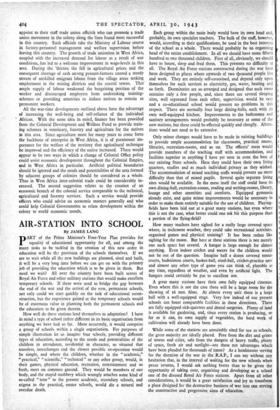AIR-STATION INTO SCHOOL
By JAMES LANG How well do these stations lend themselves to adaptation? I have in mind a type of school rather different in its basic organisation from anything we have had so far. More accurately, it would comprise a group of schools within a single organisation- For purposes of simple illustration let us imagine four schools, providing different types of education, according to the needs and potentialities of the children in attendance, residential in character, so situated that transfers, interchanges and the closest possible co-operation would be simple, and where the children, whether in the " academic," " practical," " scientific," " technical " or any other group, would, in their games, physical education, recreation, entertainment and so forth, meet on common ground. They would be members of one body, and the stupid snobbery which wrongly attaches some kind of so-called " tone" to the present academic, secondary schools, and stigma to the practical, senior schools, would die a natural and overdue death.
Each group within the main body would have its own head and, probably, its own specialist teachers. The bulk of the staff, however, would, according to their qualifications, be used in the best interests of the school as a whole. There would probably be an organising head of the entire establishment. In all we should have some fifteen hundred to two thousand children. First of all, obviously, we should have to house, sleep and feed them. This presents no difficulty at all. The Royal Air Force stations constructed during the war have been designed as places where upwards of two thousand people live r. and work. They are entirely self-contained, and depend only upon themselves for such services as electricity, gas, water, heating and so forth. Dormitories are so arranged and designed that each room contains only a few people, and, since there are several sleeping 3 sites, well separated from each other, supervision would be easy a and a co-educational school would present no problems in this respect. There are normally four large dining-halls, each with its own well-equipped kitchen. Improvements to the bathrooms and r. sanitary arrangements would probably be necessary at some of the r new stations, but these could be effected quickly and cheaply. Altera- tions would not need to be extensive.
Only minor changes would have to be made in existing buildings to provide ample accommodation for classrooms, practical rooms,
C libraries, recreation-rooms, and so on. The officers' mess would provide members of the teaching staff with accommodation, and V facilities superior to anything I have yet seen in even the best of our existing State schools. Here they could have their own living ti quarters, studies and as much individual privacy as they wished. ti
d The accommodation of mixed teaching staffs would present no more difficulty than that of mixed pupils. Several quite separate living sites would be available. In the mess itself the staff could have its own dining-hall, recreation-looms, reading and writing-rooms, library, lounge and other amenities and comforts. Equipped gymnasia already exist, and quite minor improvements would be necessary in order to make them entirely suitable for the use of children. Playing-
fields have been laid out at a great many stations, but even where s,
this is not the case, what better could one ask for this purpose than a portion of the flying-field?
How many -teachers have sighed for a really large covered space a where, in inclement weather, they could take recreational activities. a organised games and physical training? It has been rather like a
sighing for the moon. But here at these stations there is not merely one such space but several. A hangar is large enough for almost anything. Even indoor cricket and soccer for the children would not be out of the question. Imagine half a dozen covered tennis courts, badminton courts, basket-ball, stool-ball, cricket-sractice nets and almost any other type of game you can think of, playable at any time, regardless of weather, and even by artificial light. The hangars could certainly be put to excellent use.
A great many stations have their own fully equipped cinemas. Even where this is not the case there will be a large room for the showing of 16 mm. films. At almost every unit there is a large hall with a well-equipped stage. Very few indeed of our present schools can boast comparable facilities in these directions. There are fully equipped sick-quarters and dental surgeries. Plenty of land is available for gardening, and, since every station is producing, so far as it can, its own supply of vegetables, the hard work of cultivation will already have been done.
While some of the stations are unsuitably sited for use as schools, the great majority are ideally placed. Free from the dirt and grime of towns and cities, safe from the dangers of heavy traffic, plenty of space, fresh air and sunlight—are these not advantages which have been pleaded for thousands of times? As a headmaster serving for the duration of the war in the R.A.F., I can say without any hesitation that, in the interval of waiting for the new schools when peace returns, I would ask nothing better than to be given the opportunity of taking over, organising and developing as a school one of the disused Royal Air Force stations. Apart from all other considerations, it would be a great satisfaction and joy to transform a place designed foe the destructive business of war into one serving the constructive and progressive aims of education.






















 Previous page
Previous page